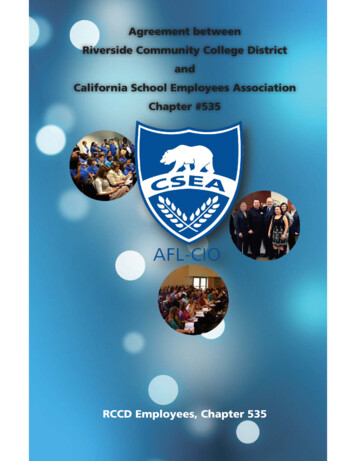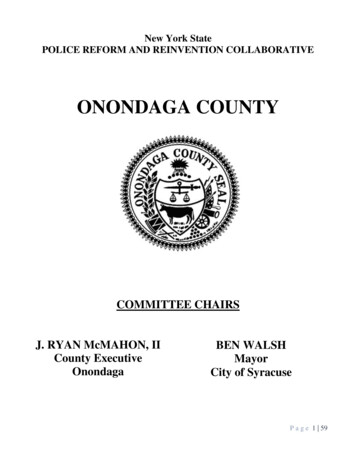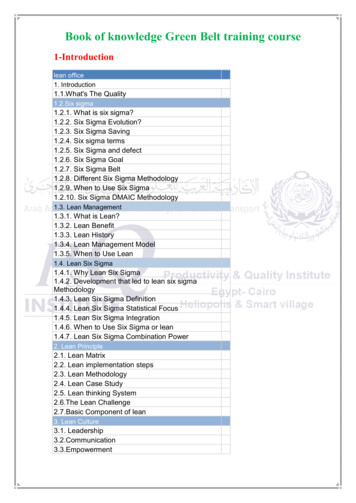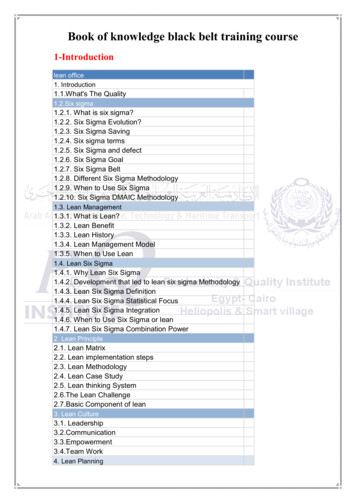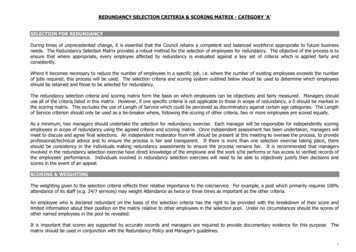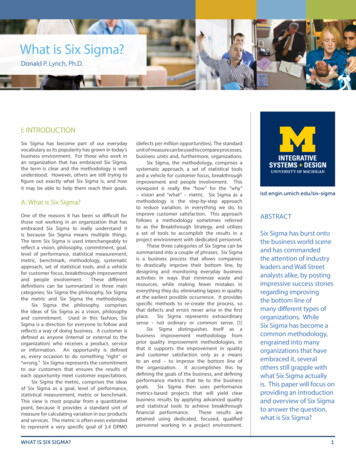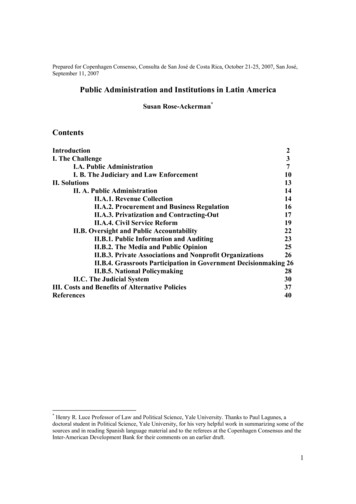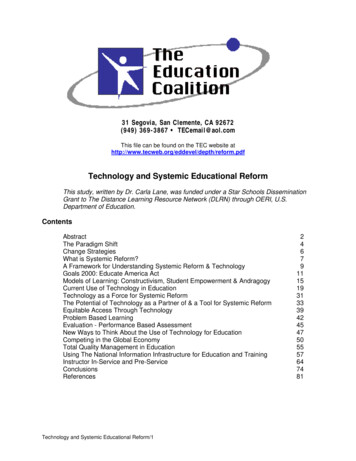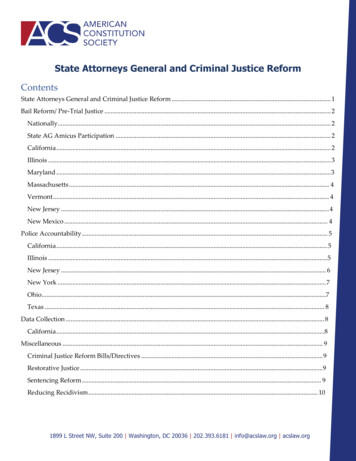
Transcription
Collaborativereform initiativeSix-Month AssessmentReport on the PhiladelphiaPolice DepartmentJames “Chip” Coldren, Steven Carter,James LaRochelle, Ashley Shultz
Collaborativereform initiativeSix-Month AssessmentReport on the PhiladelphiaPolice DepartmentJames “Chip” Coldren, Steven Carter,James LaRochelle, Ashley Shultz
This project was supported by cooperative agreement number 2013-CK-WX-K016, awarded by the Office of CommunityOriented Policing Services, U.S. Department of Justice. The opinions contained herein are those of the author(s) and do notnecessarily represent the official position or policies of the U.S. Department of Justice. References to specific agencies, com panies, products, or services should not be considered an endorsement by the author(s) or the U.S. Department of Justice.Rather, the references are illustrations to supplement discussion of the issues.This document contains preliminary analysis that is subject to further review and modification. It may not be quoted or cit ed and should not be disseminated further without the express permission of CNA or the U.S. Department of Justice. Anycopyright in this work is subject to the Government’s Unlimited Rights license as defined in FAR 52-227.14. The reproductionof this work for commercial purposes is strictly prohibited. Nongovernmental users may copy and distribute this documentin any medium, either commercial or noncommercial, provided that this copyright notice is reproduced in all copies. Non governmental users may not use technical measures to obstruct or control the reading or further copying of the copiesthey make or distribute. Nongovernmental users may not accept compensation of any manner in exchange for copies. Allother rights reserved.The Internet references cited in this publication were valid as of the date of this publication. Given that URLs and websitesare in constant flux, neither the author(s) nor the COPS Office can vouch for their current validity.Recommended citation:Coldren, James, Steven Carter, James LaRochelle, and Ashley Shultz. Six-Month Assessment Report on the Philadelphia PoliceDepartment. Collaborative Reform Initiative. Washington, DC: Office of Community Oriented Policing Services.Copyright 2015 CNA Corporation. The U.S. Department of Justice reserves a royalty-free, nonexclusive, and irrevocablelicense to reproduce, publish, or otherwise use and authorize others to use this publication for Federal Government purpos es. This publication may be freely distributed and used for noncommercial and educational purposes only.Published 2015
ContentsExecutive Summary . . . . . . . . . . . . . . . . . . . . . . . . . . . . . . . . . . . . . . . . . . . . . . . . . . . . . . . . . . . . . . . . . . . . . . . . . . . 1Background . . . . . . . . . . . . . . . . . . . . . . . . . . . . . . . . . . . . . . . . . . . . . . . . . . . . . . . . . . . . . . . . . . . . . . . . . . . . . . . . . . . . . . . . . . 1Progress toward report recommendations . . . . . . . . . . . . . . . . . . . . . . . . . . . . . . . . . . . . . . . . . . . . . . . . . . . . . . . . . . . . 2Next steps . . . . . . . . . . . . . . . . . . . . . . . . . . . . . . . . . . . . . . . . . . . . . . . . . . . . . . . . . . . . . . . . . . . . . . . . . . . . . . . . . . . . . . . . . . . . 2Chapter 1 . Introduction . . . . . . . . . . . . . . . . . . . . . . . . . . . . . . . . . . . . . . . . . . . . . . . . . . . . . . . . . . . . . . . . . . . . . . . . 3Background . . . . . . . . . . . . . . . . . . . . . . . . . . . . . . . . . . . . . . . . . . . . . . . . . . . . . . . . . . . . . . . . . . . . . . . . . . . . . . . . . . . . . . . . . . 3Approach . . . . . . . . . . . . . . . . . . . . . . . . . . . . . . . . . . . . . . . . . . . . . . . . . . . . . . . . . . . . . . . . . . . . . . . . . . . . . . . . . . . . . . . . . . . . 5Organization of this six-month assessment report . . . . . . . . . . . . . . . . . . . . . . . . . . . . . . . . . . . . . . . . . . . . . . . . . . . . . 6Chapter 2 . Use of Force Policies . . . . . . . . . . . . . . . . . . . . . . . . . . . . . . . . . . . . . . . . . . . . . . . . . . . . . . . . . . . . . . . . 7Finding 1 . . . . . . . . . . . . . . . . . . . . . . . . . . . . . . . . . . . . . . . . . . . . . . . . . . . . . . . . . . . . . . . . . . . . . . . . . . . . . . . . . . . . . . . . . . . . 7Finding 2 . . . . . . . . . . . . . . . . . . . . . . . . . . . . . . . . . . . . . . . . . . . . . . . . . . . . . . . . . . . . . . . . . . . . . . . . . . . . . . . . . . . . . . . . . . . . 9Finding 3 . . . . . . . . . . . . . . . . . . . . . . . . . . . . . . . . . . . . . . . . . . . . . . . . . . . . . . . . . . . . . . . . . . . . . . . . . . . . . . . . . . . . . . . . . . . 11Finding 4 . . . . . . . . . . . . . . . . . . . . . . . . . . . . . . . . . . . . . . . . . . . . . . . . . . . . . . . . . . . . . . . . . . . . . . . . . . . . . . . . . . . . . . . . . . . 11Finding 5 . . . . . . . . . . . . . . . . . . . . . . . . . . . . . . . . . . . . . . . . . . . . . . . . . . . . . . . . . . . . . . . . . . . . . . . . . . . . . . . . . . . . . . . . . . . 12Finding 6 . . . . . . . . . . . . . . . . . . . . . . . . . . . . . . . . . . . . . . . . . . . . . . . . . . . . . . . . . . . . . . . . . . . . . . . . . . . . . . . . . . . . . . . . . . . 12Finding 7 . . . . . . . . . . . . . . . . . . . . . . . . . . . . . . . . . . . . . . . . . . . . . . . . . . . . . . . . . . . . . . . . . . . . . . . . . . . . . . . . . . . . . . . . . . . 13Finding 8 . . . . . . . . . . . . . . . . . . . . . . . . . . . . . . . . . . . . . . . . . . . . . . . . . . . . . . . . . . . . . . . . . . . . . . . . . . . . . . . . . . . . . . . . . . . 14Finding 9 . . . . . . . . . . . . . . . . . . . . . . . . . . . . . . . . . . . . . . . . . . . . . . . . . . . . . . . . . . . . . . . . . . . . . . . . . . . . . . . . . . . . . . . . . . . 16Finding 10 . . . . . . . . . . . . . . . . . . . . . . . . . . . . . . . . . . . . . . . . . . . . . . . . . . . . . . . . . . . . . . . . . . . . . . . . . . . . . . . . . . . . . . . . . . 18Chapter 3 . Basic Recruit Training . . . . . . . . . . . . . . . . . . . . . . . . . . . . . . . . . . . . . . . . . . . . . . . . . . . . . . . . . . . . . . 21Finding 12 . . . . . . . . . . . . . . . . . . . . . . . . . . . . . . . . . . . . . . . . . . . . . . . . . . . . . . . . . . . . . . . . . . . . . . . . . . . . . . . . . . . . . . . . . . 23Finding 13 . . . . . . . . . . . . . . . . . . . . . . . . . . . . . . . . . . . . . . . . . . . . . . . . . . . . . . . . . . . . . . . . . . . . . . . . . . . . . . . . . . . . . . . . . . 23Finding 14 . . . . . . . . . . . . . . . . . . . . . . . . . . . . . . . . . . . . . . . . . . . . . . . . . . . . . . . . . . . . . . . . . . . . . . . . . . . . . . . . . . . . . . . . . . 24Finding 15 . . . . . . . . . . . . . . . . . . . . . . . . . . . . . . . . . . . . . . . . . . . . . . . . . . . . . . . . . . . . . . . . . . . . . . . . . . . . . . . . . . . . . . . . . . 25Finding 16 . . . . . . . . . . . . . . . . . . . . . . . . . . . . . . . . . . . . . . . . . . . . . . . . . . . . . . . . . . . . . . . . . . . . . . . . . . . . . . . . . . . . . . . . . . 27Finding 17 . . . . . . . . . . . . . . . . . . . . . . . . . . . . . . . . . . . . . . . . . . . . . . . . . . . . . . . . . . . . . . . . . . . . . . . . . . . . . . . . . . . . . . . . . . 27Finding 18 . . . . . . . . . . . . . . . . . . . . . . . . . . . . . . . . . . . . . . . . . . . . . . . . . . . . . . . . . . . . . . . . . . . . . . . . . . . . . . . . . . . . . . . . . . . 28Finding 19 . . . . . . . . . . . . . . . . . . . . . . . . . . . . . . . . . . . . . . . . . . . . . . . . . . . . . . . . . . . . . . . . . . . . . . . . . . . . . . . . . . . . . . . . . . 28Finding 20 . . . . . . . . . . . . . . . . . . . . . . . . . . . . . . . . . . . . . . . . . . . . . . . . . . . . . . . . . . . . . . . . . . . . . . . . . . . . . . . . . . . . . . . . . . 29Finding 21 . . . . . . . . . . . . . . . . . . . . . . . . . . . . . . . . . . . . . . . . . . . . . . . . . . . . . . . . . . . . . . . . . . . . . . . . . . . . . . . . . . . . . . . . . . 30Chapter 4 . In-Service Training . . . . . . . . . . . . . . . . . . . . . . . . . . . . . . . . . . . . . . . . . . . . . . . . . . . . . . . . . . . . . . . . . 31Finding 22 . . . . . . . . . . . . . . . . . . . . . . . . . . . . . . . . . . . . . . . . . . . . . . . . . . . . . . . . . . . . . . . . . . . . . . . . . . . . . . . . . . . . . . . . . . . 31Finding 23 . . . . . . . . . . . . . . . . . . . . . . . . . . . . . . . . . . . . . . . . . . . . . . . . . . . . . . . . . . . . . . . . . . . . . . . . . . . . . . . . . . . . . . . . . . 33Finding 24 . . . . . . . . . . . . . . . . . . . . . . . . . . . . . . . . . . . . . . . . . . . . . . . . . . . . . . . . . . . . . . . . . . . . . . . . . . . . . . . . . . . . . . . . . . 35Finding 25 . . . . . . . . . . . . . . . . . . . . . . . . . . . . . . . . . . . . . . . . . . . . . . . . . . . . . . . . . . . . . . . . . . . . . . . . . . . . . . . . . . . . . . . . . . 35Finding 26 . . . . . . . . . . . . . . . . . . . . . . . . . . . . . . . . . . . . . . . . . . . . . . . . . . . . . . . . . . . . . . . . . . . . . . . . . . . . . . . . . . . . . . . . . . 38– iii –
Collaborative Reform InitiativeSix-Month Assessment Report on the Philadelphia Police DepartmentFinding 27 . . . . . . . . . . . . . . . . . . . . . . . . . . . . . . . . . . . . . . . . . . . . . . . . . . . . . . . . . . . . . . . . . . . . . . . . . . . . . . . . . . . . . . . . . . 39Finding 28 . . . . . . . . . . . . . . . . . . . . . . . . . . . . . . . . . . . . . . . . . . . . . . . . . . . . . . . . . . . . . . . . . . . . . . . . . . . . . . . . . . . . . . . . . . 39Finding 29 . . . . . . . . . . . . . . . . . . . . . . . . . . . . . . . . . . . . . . . . . . . . . . . . . . . . . . . . . . . . . . . . . . . . . . . . . . . . . . . . . . . . . . . . . . . 40Finding 30 . . . . . . . . . . . . . . . . . . . . . . . . . . . . . . . . . . . . . . . . . . . . . . . . . . . . . . . . . . . . . . . . . . . . . . . . . . . . . . . . . . . . . . . . . . 41Chapter 5 . Investigations . . . . . . . . . . . . . . . . . . . . . . . . . . . . . . . . . . . . . . . . . . . . . . . . . . . . . . . . . . . . . . . . . . . . . 43Finding 31 . . . . . . . . . . . . . . . . . . . . . . . . . . . . . . . . . . . . . . . . . . . . . . . . . . . . . . . . . . . . . . . . . . . . . . . . . . . . . . . . . . . . . . . . . . 44Finding 32 . . . . . . . . . . . . . . . . . . . . . . . . . . . . . . . . . . . . . . . . . . . . . . . . . . . . . . . . . . . . . . . . . . . . . . . . . . . . . . . . . . . . . . . . . . . 45Finding 33 . . . . . . . . . . . . . . . . . . . . . . . . . . . . . . . . . . . . . . . . . . . . . . . . . . . . . . . . . . . . . . . . . . . . . . . . . . . . . . . . . . . . . . . . . . 46Finding 34 . . . . . . . . . . . . . . . . . . . . . . . . . . . . . . . . . . . . . . . . . . . . . . . . . . . . . . . . . . . . . . . . . . . . . . . . . . . . . . . . . . . . . . . . . . 47Finding 35 . . . . . . . . . . . . . . . . . . . . . . . . . . . . . . . . . . . . . . . . . . . . . . . . . . . . . . . . . . . . . . . . . . . . . . . . . . . . . . . . . . . . . . . . . . . 47Finding 36 . . . . . . . . . . . . . . . . . . . . . . . . . . . . . . . . . . . . . . . . . . . . . . . . . . . . . . . . . . . . . . . . . . . . . . . . . . . . . . . . . . . . . . . . . . . 48Finding 37 . . . . . . . . . . . . . . . . . . . . . . . . . . . . . . . . . . . . . . . . . . . . . . . . . . . . . . . . . . . . . . . . . . . . . . . . . . . . . . . . . . . . . . . . . . 50Finding 38 . . . . . . . . . . . . . . . . . . . . . . . . . . . . . . . . . . . . . . . . . . . . . . . . . . . . . . . . . . . . . . . . . . . . . . . . . . . . . . . . . . . . . . . . . . 50Finding 39 . . . . . . . . . . . . . . . . . . . . . . . . . . . . . . . . . . . . . . . . . . . . . . . . . . . . . . . . . . . . . . . . . . . . . . . . . . . . . . . . . . . . . . . . . . . 51Chapter 6 . Use of Deadly Force Review and Officer Accountability . . . . . . . . . . . . . . . . . . . . . . . . . . . . . .53Finding 40 . . . . . . . . . . . . . . . . . . . . . . . . . . . . . . . . . . . . . . . . . . . . . . . . . . . . . . . . . . . . . . . . . . . . . . . . . . . . . . . . . . . . . . . . . . 53Finding 41 . . . . . . . . . . . . . . . . . . . . . . . . . . . . . . . . . . . . . . . . . . . . . . . . . . . . . . . . . . . . . . . . . . . . . . . . . . . . . . . . . . . . . . . . . . . 57Finding 42 . . . . . . . . . . . . . . . . . . . . . . . . . . . . . . . . . . . . . . . . . . . . . . . . . . . . . . . . . . . . . . . . . . . . . . . . . . . . . . . . . . . . . . . . . . . 57Finding 43 . . . . . . . . . . . . . . . . . . . . . . . . . . . . . . . . . . . . . . . . . . . . . . . . . . . . . . . . . . . . . . . . . . . . . . . . . . . . . . . . . . . . . . . . . . 58Finding 44 . . . . . . . . . . . . . . . . . . . . . . . . . . . . . . . . . . . . . . . . . . . . . . . . . . . . . . . . . . . . . . . . . . . . . . . . . . . . . . . . . . . . . . . . . . 59Chapter 7 . External Oversight and Transparency . . . . . . . . . . . . . . . . . . . . . . . . . . . . . . . . . . . . . . . . . . . . . . . 61Finding 45 . . . . . . . . . . . . . . . . . . . . . . . . . . . . . . . . . . . . . . . . . . . . . . . . . . . . . . . . . . . . . . . . . . . . . . . . . . . . . . . . . . . . . . . . . . 61Finding 46 . . . . . . . . . . . . . . . . . . . . . . . . . . . . . . . . . . . . . . . . . . . . . . . . . . . . . . . . . . . . . . . . . . . . . . . . . . . . . . . . . . . . . . . . . . 63Finding 47 . . . . . . . . . . . . . . . . . . . . . . . . . . . . . . . . . . . . . . . . . . . . . . . . . . . . . . . . . . . . . . . . . . . . . . . . . . . . . . . . . . . . . . . . . . 63Finding 48 . . . . . . . . . . . . . . . . . . . . . . . . . . . . . . . . . . . . . . . . . . . . . . . . . . . . . . . . . . . . . . . . . . . . . . . . . . . . . . . . . . . . . . . . . . 65Chapter 8 . Conclusion and Next Steps . . . . . . . . . . . . . . . . . . . . . . . . . . . . . . . . . . . . . . . . . . . . . . . . . . . . . . . . . 67Appendix A . Philadelphia Police Department Recommendation Status Summary . . . . . . . . . . . . . . . 69Appendix B . Acronyms, Abbreviations, and Initialisms . . . . . . . . . . . . . . . . . . . . . . . . . . . . . . . . . . . . . . . . . . 81About CNA . . . . . . . . . . . . . . . . . . . . . . . . . . . . . . . . . . . . . . . . . . . . . . . . . . . . . . . . . . . . . . . . . . . . . . . . . . . . . . . . . . . 83About the COPS Office . . . . . . . . . . . . . . . . . . . . . . . . . . . . . . . . . . . . . . . . . . . . . . . . . . . . . . . . . . . . . . . . . . . . . . . . 85– iv –
Executive SummaryBackgroundIn June 2013, Commissioner Charles H. Ramsey of the Philadelphia Police Department (PPD) requestedtechnical assistance from the U.S. Department of Justice (DOJ) Office of Community Oriented PolicingServices (COPS Office) through the Collaborative Reform Initiative for Technical Assistance (CRI-TA). WhilePhiladelphia was experiencing reductions in violent crime and assaults against the police, the city was alsoexperiencing increases in fatal officer-involved shootings.CRI-TA provides law enforcement agencies in the United States with an option to closely assess emergingissues of concern which, if left unchecked, might develop into serious problems requiring extensive andexpensive reform efforts. Through CRI-TA, independent organizations conduct assessments of the identi fied problems in a police agency and recommend reforms aimed at eliminating or substantially reducingthe problems; they then monitor the police agency’s implementation of those reforms for 12 to 18 months,helping to insure that the reforms have a lasting effect.The goals of CRI-TA at the PPD include examining and reforming deadly force training, policies, and practic es in the PPD and improving community involvement in these matters. The objectives of this assessmentinclude the following: Enhance training as it relates to officer and public safety in deadly force situations. Improve the quality and transparency of deadly force investigations from both criminal and adminis trative standpoints. Strengthen the use of force review process. Institutionalize organizational learning processes and practices related to deadly force incidents.At the request of the COPS Office, CNA1 conducted a thorough assessment of trends and patterns, training,and policies and practices pertaining to use of force at the PPD.The COPS Office published the initial assessment report, Collaborative Reform Initiative: An Assessment ofDeadly Force in the Philadelphia Police Department, in March 2015.2 That report presented a detailed analy sis of use of force incidents in the PPD from 2007 to 2013. The analysis revealed that during those years, thePPD averaged about 50 officer-involved shootings (OIS) per year and that the number of OISs had declinedin recent years. However, the percentage of OISs that involved PPD officers shooting at unarmed individualsincreased over that same time period, from approximately eight percent to more than 20 percent.3While the release of the assessment report in March marked the completion of the assessment phase, theCOPS Office, CNA, and the PPD have continued their collaboration to support the implementation of the91 recommended reforms included in that report. Tracking the implementation progress of these reformsbegan in April 2015 and will continue through October 2016, a period of about 18 months.1. CNA is a research and analysis firm specializing in policing reform issues around use of force and police-community relations. CNA worked with the COPS Office todevelop the Collaborative Reform Initiative and has worked on CRI-TA projects in Las Vegas, Nevada; Spokane, Washington; and Fayetteville, North Carolina, in additionto the Philadelphia project.2. George Fachner and Steven Carter, An Assessment of Deadly Force in the Philadelphia Police Department, Collaborative Reform Initiative (Washington, DC: Office ofCommunity Oriented Policing Services, 2015), .pdf.3. Fachner and Carter, An Assessment of Deadly Force in the Philadelphia Police Department, 17–33 (see note 2).–1–
Collaborative Reform InitiativeSix-Month Assessment Report on the Philadelphia Police DepartmentThis six-month assessment report is the first of two progress reports that the COPS Office will publish onthe PPD’s progress toward implementation of the recommended reforms. It will inform all stakeholders (i.e.,the PPD, the DOJ, and the Philadelphia community) of the PPD’s progress to date. Over the next year, CNAwill conduct additional site visits and interviews with PPD personnel and community members; directlyobserve PPD activities; analyze related data; and continue to review supporting documentation providedby the PPD. The final assessment report will document the status of the implementation of the recom mended reforms at the completion of the monitoring phase. The COPS Office will make the final assess ment report publicly available.Progress toward report recommendationsThis six-month assessment report assigns one of four statuses to each of the 91 recommendations con tained in the assessment report: Complete, Partially complete, In progress, or No progress. Table 1 showsthe tally of the status of the 91 recommendations as of October 30, 2015. To date, the PPD has completed21 recommendations, has made demonstrable progress on an additional 61 recommendations (those list ed as Partially complete and In progress), and has made no progress on nine recommendations. ThePPD has made positive progress toward implementing the reforms. At the one-third mark in the imple mentation phase (after six of 18 months), 24 percent of the 91 reform recommendations are Complete orPartially complete with another 66 percent In progress. Thus, 90 percent of the 91 recommendations forthe PPD are Complete, Partially complete, or In progress.Table 1. Status of PPD assessment report recommendationsStatusReforms/Recommendations (N)Percent (%)Complete2123Partially complete11In progress6066No progress91091100TotalNext stepsOver the next year, the assessment team will continue to monitor the PPD’s progress towards implement ing the reform recommendations. A final assessment report on the implementation of the CollaborativeReform Initiative in the PPD will be provided in early 2017.–2–
Chapter 1. IntroductionBackgroundIn June 2013, Commissioner Charles H. Ramsey of the Philadelphia Police Department (PPD) requestedtechnical assistance from the U.S. Department of Justice (DOJ) Office of Community Oriented PolicingServices (COPS Office) through the Collaborative Reform Initiative for Technical Assistance (CRI-TA). WhilePhiladelphia was experiencing reductions in violent crime and assaults against the police, the city was alsoexperiencing increases in fatal officer-involved shootings.CRI-TA provides law enforcement agencies in the United States with an option to closely assess emergingissues of concern which, if left unchecked, might develop into serious problems requiring extensive andexpensive reform efforts—possibly even consent decrees and appointment of independent monitors.Through CRI-TA, independent organizations conduct assessments of the identified problems in a policeagency and recommend reforms aimed at eliminating or substantially reducing the problems; they thenmonitor the police agency’s implementation of those reforms for 12 to 18 months, helping insure that thereforms have a lasting effect.In the case of the PPD, the goals of CRI-TA, which were mutually agreed upon by the COPS Office and thePPD, included examining and reforming deadly force training, policies, practices in the PPD, taking intoaccount national standards, best practices, current and emerging research, and improving community in volvement in these matters. The agreed upon objectives of this initiative included the following: Enhance training as it relates to officer and public safety in deadly force situations. Improve the quality and transparency of deadly force investigations from both criminal and adminis trative standpoints. Strengthen the use of force (UOF) review process. Institutionalize organizational learning processes and practices related to deadly force incidents.At the request of the COPS Office, CNA conducted a thorough assessment of trends and patterns, training,and policies and practices pertaining to use of force at the PPD.In March 2015, following a 12-month assessment, the COPS Office published CNA’s initial assessment re port, An Assessment of Deadly Force in the Philadelphia Police Department.4 That report presented a detailedanalysis of UOF incidents in the PPD from 2007 to 2013. This analysis revealed that during those years, thePPD averaged about 50 officer-involved shootings (OIS) per year, and that the number of OISs declined inrecent years. However, the percentage of OISs that involved PPD officers shooting at unarmed individualsincreased over that same time period, from approximately eight percent to more than 20 percent.5While the release of the initial assessment report marked the completion of the assessment phase, theCOPS Office, CNA, and the PPD have continued their collaboration to support the implementation of 91recommended reforms included in that report. Tracking the implementation progress of these reformsbegan in April 2015 and will continue through October 2016, a period of about 18 months.4. Fachner and Carter, An Assessment of Deadly Force in the Philadelphia Police Department (see note 2).5. Fachner and Carter, An Assessment of Deadly Force in the Philadelphia Police Department, 17–33 (see note 2).–3–
Collaborative reform initiativeSix-Month Assessment Report on the Philadelphia Police DepartmentThis six-month assessment report is the first of two reports that the COPS Office will publish on the PPD’sprogress toward implementation of the recommended reforms. It will inform all stakeholders (i.e., the PPD,the DOJ, and the Philadelphia community) of the PPD’s progress to date. The final assessment report willdocument the status of the implementation at the completion of the monitoring phase.In this six-month assessment report, each recommendation has been assigned one of four statuses (seetable 2).Table 2. Definitions of recommendation statusesStatusDefinitionCompleteThe recommendation has been sufficiently demonstrated to be complete basedon the assessors’ review of submitted materials, observations, and analysis.Ongoing review of this recommendation throughout the monitoring periodwill determine whether this reform has been fully institutionalized within thedepartment.Partially completeThe agency has submitted materials that they believe demonstrate completionof the recommendation. However, the assessors have deemed that additionaleffort is needed to complete the recommendation. The agency has stated thatno further work will be forthcoming on the recommendation.In progressImplementation of the recommendation is currently in progress based on theassessors’ review of submitted materials, observations, and analysis.No progressThe agency has not sufficiently demonstrated progress toward implementationof the recommendation.There are important caveats to the statuses reported here. Every recommendation from the initial assess ment report is subject to review over the entire course of the program, including those recommendationsthat have reached the status of “Complete.” This is necessary to ensure that the completed recommenda tions continue to be institutionalized within the department and to examine potential modifications to theimplementation of these reforms. A status of “Partially complete” is assigned to those recommendationswhere the department did not fully implement a recommendation as stated in the initial assessment re port and has no further plans to continue working on or fully implementing the recommendation. If theassessment team believes that the PPD will continue to work on the recommendation, the status is listedas “In progress.” This status is also used to indicate instances in which the department has made consider able progress and has submitted enough materials for the assessors to make determination that construc tive steps have been taken toward completion. Recommendations listed as “No progress” are those forwhich either (1) insufficient materials were provided for the assessors to document demonstrative progresstowards completion, (2) the department was unable to implement the recommendations because of cir cumstances within or beyond their control (e.g., they have not yet begun implementation of changes orthey are restricted by state legislation or contractual issues), or (3) the department has noted that it doesnot have plans to implement the recommendation.Table 3 shows a tally of the status of report recommendations. To date, the PPD has completed 21 recom mendations, has partially completed or made demonstrable progress on an additional 61 recommenda tions, and has made no progress on nine recommendations. The PPD has made positive progress toward–4–
Chapter 1. Introductionimplementing the reforms. At the one-third mark in the monitoring phase (after six of 18 months), 24 per cent of the 91 reform recommendations are Complete or Partially complete with another 66 percent Inprogress. Thus, 90 percent of the 91 recommendations at the PPD are Complete, Partially complete, orIn progress.Table 3. Status of PPD initial assessment report recommendationsStatusReforms/Recommendations (N)Percent (%)Complete2123Partially complete11In progress6066No progress91091100TotalApproachThe goals of the CRI-TA monitoring phase are for the members of the assessment team to fully understandthe steps the PPD has taken toward implementing the recommended reforms and to collect and review asmuch evidence as necessary to confirm that those steps have been completed. In order to track the imple mentation progress, the assessment team provided the PPD with a document outlining processes thatprovide evidence of compliance. That document included examples of important steps the departmentshould take in completing the reforms as well as a list of formal documentation necessary to provide evi dence of the implementation progress.From April to October 2015, the assessment team conducted two site visits, maintained frequent contactwith the PPD, and reviewed documents containing evidence of the PPD’s deliberate actions and progresstowards agency reform based on the 91 recommendations in the initial assessment report. To date, thePPD has submitted more than 100 documents and files for review covering most of the recommendations,including policies and directives, internal bulletins and memoranda, training lesson plans, attendance re cords, OIS investigation files, e-mail communications, and other pertinent documentation. The a
Appendix A. Philadelphia Police Department Recommendation Status Summary 69 Appendix B. Acronyms, Abbreviations, and Initialisms 81 About CNA 83 About the COPS Office 85 - iv - Executive Summary Background In June 2013, Commissioner Charles H. Ramsey of the Philadelphia Police Department (PPD) requested
